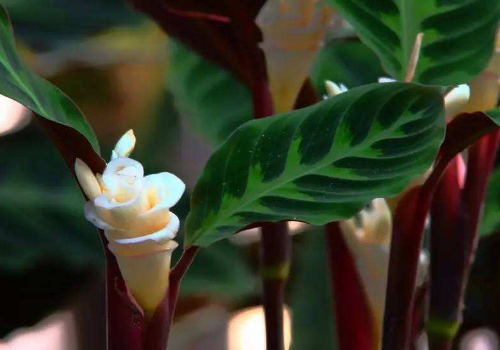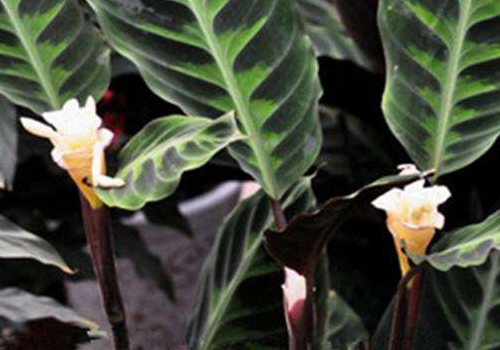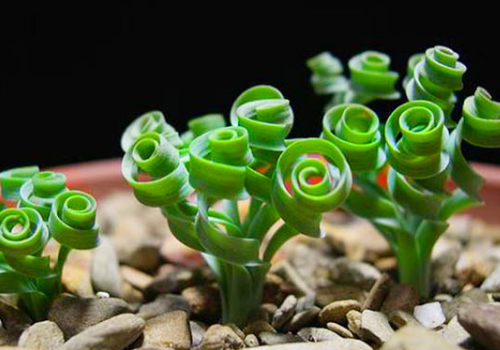What about when velvet taro blossoms or not?
Velvet taro can well absorb harmful substances in the air, which can greatly improve the home environment. When does velvet taro blossom? What if it doesn't bloom:
When will velvet taro bloom:
The florescence of velvet taro is from May to June every year. Head ovate, goose-egg-sized, borne alone on scape, scape varied in length, bracts imbricate, broadly ovate, ca. 5 cm wide, purple inside; bracteoles linear; sepals oblong, up to 2.5 cm long; Corolla coronoid or white.

What if velvet taro doesn't blossom:
1. High humidity. The main reason is too much watering, especially autumn, autumn is the period of flower bud differentiation, too much watering leads to incomplete flower bud differentiation, it is difficult to form a complete flower bud.
2. Lack of light. The flowering time of velvet taro is in the late spring and early winter, so the maintenance of autumn and winter is very important, the lack of sunlight leads to the lack of nutrients in the plant itself, and it is difficult to grow quickly in spring, let alone to produce the nutrients needed for flowering.
3. Too much nitrogen fertilizer. Too much nitrogen fertilizer will promote the rapid growth of branches and leaves, especially in spring, sprouting vigorously, breaking through the leaf buds formed in late autumn and early winter, crazy long leaves, lack of flower buds, it is difficult to blossom.
Therefore, according to the above analysis, to ensure that velvet taro bloom, but also in autumn, to avoid the emergence of the above three points, flowering is still very simple.
Now you know something about velvet taro.
When will velvet taro bloom (a few months) what if velvet taro doesn't blossom?
Velvet taro is a kind of plant with high ornamental value, its leaves are relatively large, green all the year round, and there are some patterns on it, which looks very beautiful. Because velvet taro is generally mainly to appreciate leaves, so many people ignore its flowers, in fact, it is also a flowering variety.
When will velvet taro bloom (a few months)
The florescence of velvet taro is from May to June every year. Head ovate, goose-egg-sized, borne alone on scape, scape varied in length, bracts imbricate, broadly ovate, ca. 5 cm wide, purple inside; bracteoles linear; sepals oblong, up to 2.5 cm long; Corolla coronoid or white.
What if velvet taro doesn't blossom?
1. High humidity. The main reason is too much watering, especially autumn, autumn is the period of flower bud differentiation, too much watering leads to incomplete flower bud differentiation, it is difficult to form a complete flower bud.
2. Lack of light. The flowering time of velvet taro is in the late spring and early winter, so the maintenance of autumn and winter is very important, the lack of sunlight leads to the lack of nutrients in the plant itself, and it is difficult to grow quickly in spring, let alone to produce the nutrients needed for flowering.
3. Too much nitrogen fertilizer. Too much nitrogen fertilizer will promote the rapid growth of branches and leaves, especially in spring, sprouting vigorously, breaking through the leaf buds formed in late autumn and early winter, crazy long leaves, lack of flower buds, it is difficult to blossom.
Therefore, according to the above analysis, to ensure that velvet taro bloom, but also in autumn, to avoid the emergence of the above three points, flowering is still very simple.
How to prolong the florescence of velvet taro
1. The normal flowering period of velvet taro is about one month, which can be prolonged with a little attention in maintenance.
2. Stop fertilizing. During flowering, do not fertilize, move the plant to a warm and shaded place indoors, reduce the light, especially do not receive strong light.
3, pay attention to timely ventilation, do not open windows in windy weather, so as not to cause flowers to fall off. Open the window in time for ventilation in a sunny day to avoid indoor pollution.
4. Control watering. During flowering, reduce the amount of water and try not to spray water on leaves and flowers. At night, it is necessary to ensure that the potted soil and leaves are dry and reduce the number of fallen flowers.
The four Seasons Fertilizer and Water skills of Velvet Taro
1. Fertilization. There are many requirements for fertilizer and water, but they are most afraid of random fertilization, concentrated fertilizer and partial application of nitrogen, phosphorus and potash fertilizer. It is required to follow the fertilization principle of "light fertilizer applied frequently, less and more times, and complete nutrition".
2. Watering. Velvet taro is commonly used in flowerpots with a diameter of 15 to 20 centimeters. Adequate moisture and high air humidity should be maintained during the growing season, and water is often sprayed to the leaves and around the plant to increase air humidity and keep the basin soil moist. When the temperature is low in winter, the basin soil can be slightly dry.
3. Spring, summer and autumn: water once every 4 days for outdoor maintenance and once for 2-6 days for indoor maintenance. The interval period of watering in sunny or high temperature period is shorter, and the interval period is longer or not during rainy or low temperature days. Watering time should be arranged as early as possible when the temperature is low in the morning. Summer is watered in the morning or evening when the temperature is low, and plants are often sprayed.
4. Winter: in the dormant period in winter, the main task is to control fertilizer and water, the interval period is about 7-10 days, the interval period is shorter in sunny days or high temperature period, and the interval period is longer or no watering in rainy days or low temperature periods. Watering time is arranged as far as possible when the temperature is high at noon on a sunny day.
If velvet taro is cultivated well, it usually blossoms in early summer, and the flowers are mainly white. Of course, there are also some people who do not blossom because of improper breeding, which is generally caused by watering, fertilization and lighting. We can observe the actual situation and then carry out treatment.
How to raise velvet taro and how to prolong the florescence
The yellowing of velvet taro leaves is usually caused by fat and water or light. How to raise velvet taro? How to prolong the florescence:
How to raise velvet taro:
1. The optimum temperature for the growth of velvet taro is 18-25 ℃. The winter temperature should not be lower than 13 ℃ and the summer temperature should not exceed 35 ℃, otherwise it would be extremely disadvantageous to the growth of velvet taro and cause the growth of stems and leaves to stop or freeze to death.
2. Velvet taro has a high requirement for moisture. During the growing season, it should be fully watered to keep the basin soil moist. But if the soil is too wet, it will cause root rot and even death, which should be paid special attention to.
3. If the air humidity is small, the leaf curls immediately and the response is very sensitive. For indoor cultivation, the air humidity must be kept at 70%-80%. Keep a little dry in winter, the over-wet leaves are easy to turn yellow and wilt.
4. The rotten leaf soil with fertile, loose and good drainage is the most suitable. Potted soil is a mixture of cultivated soil, peat soil and coarse sand.
How to prolong the florescence of velvet taro:
1. The normal flowering period of velvet taro is about one month, which can be prolonged with a little attention in maintenance.
2. Stop fertilizing. During flowering, do not fertilize, move the plant to a warm and shaded place indoors, reduce the light, especially do not receive strong light.
3, pay attention to timely ventilation, do not open windows in windy weather, so as not to cause flowers to fall off. Open the window in time for ventilation in a sunny day to avoid indoor pollution.
4. Control watering. During flowering, reduce the amount of water and try not to spray water on leaves and flowers. At night, it is necessary to ensure that the potted soil and leaves are dry and reduce the number of fallen flowers.
All right, have you guys learned how to raise velvet taro?
- Prev

What is the reason for the yellow and drooping leaves of velvet bamboo taro? how to solve it?
Generally, we can start with the growth habits, and it is necessary to strengthen the management of wastewater in the later stage of culture. What is the reason for the yellow and drooping leaves of velvet bamboo taro? How to solve: what is the reason why velvet bamboo taro leaves are yellow and drooping: 1, there is little water in summer. Velvet taro prefers a humid growing environment.
- Next

When does the spring grass bloom and die?
Spring grass is a very interesting plant. It completes its very unique shape by twisting its leaves. When does spring grass bloom? When will the flowers bloom? When will the spring grass bloom? The flowering of the spring grass is in February of each year.
Related
- Fuxing push coffee new agricultural production and marketing class: lack of small-scale processing plants
- Jujube rice field leisure farm deep ploughing Yilan for five years to create a space for organic food and play
- Nongyu Farm-A trial of organic papaya for brave women with advanced technology
- Four points for attention in the prevention and control of diseases and insect pests of edible fungi
- How to add nutrient solution to Edible Fungi
- Is there any good way to control edible fungus mites?
- Open Inoculation Technology of Edible Fungi
- Is there any clever way to use fertilizer for edible fungus in winter?
- What agents are used to kill the pathogens of edible fungi in the mushroom shed?
- Rapid drying of Edible Fungi

